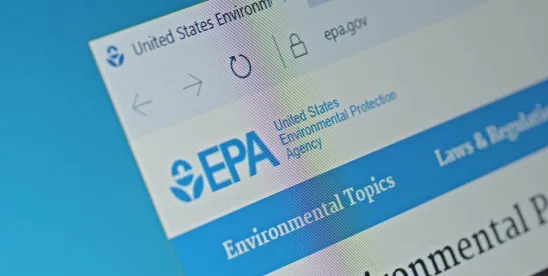On July 10, 2024, the U.S. Environmental Protection Agency (EPA) published a compliance guide for its final methylene chloride risk management rule issued under the Toxic Substances Control Act (TSCA). According to EPA, the compliance guide will help industry, workers, and other interested stakeholders understand and comply with the new regulations to prevent injuries, long-term illnesses, and deaths. EPA also announced that in June 2024, it released a fact sheet on the rule containing information on who is subject to the rule along with a summary of compliance timelines.
Background
As reported in our May 17, 2024, memorandum, EPA issued on May 8, 2024, a final rule to address the unreasonable risk of injury to health that EPA identified as caused by methylene chloride under its conditions of use (COU). 89 Fed. Reg. 39254. According to EPA, the final rule will prevent serious illness and death associated with uncontrolled exposures to methylene chloride by preventing consumer access to methylene chloride and by restricting the industrial and commercial use of methylene chloride while also allowing for a reasonable transition period where an industrial and commercial use of methylene chloride is being prohibited, will provide a time-limited exemption for a critical or essential use of methylene chloride for which no technically and economically feasible safer alternative is available, and will protect workers from the unreasonable risk of methylene chloride while on the job. The final rule was effective July 8, 2024.
Compliance Guide
According to EPA, the compliance guide helps entities understand the final rule’s requirements and their responsibilities under the rule. The guide provides detailed information on prohibitions in the rule and associated compliance timeframes, as well as information on the Workplace Chemical Protection Program (WCPP), recordkeeping requirements, downstream notifications, and other requirements applicable to those entities that may continue use of methylene chloride with strict workplace controls.
EPA states that the compliance guide is useful for entities that manufacture (including import), process, distribute in commerce, use, or dispose of methylene chloride or products containing methylene chloride. This includes the use of methylene chloride in laboratory settings. EPA notes that the compliance guide includes special attention to the interests and needs of small businesses.
EPA suggests that potentially exposed persons, such as workers and others in the workplace, “may also want to refer to the compliance guide to understand the risks from methylene chloride exposure and protections that are required in the workplace.” The guide will also be beneficial to consumers, community members, or anyone else who may be affected by exposure to methylene chloride.
Commentary
Bergeson & Campbell, P.C. (B&C®) is pleased that EPA issued the compliance guide and commends EPA for developing a document that is easy to understand and will aid readers when consulting the underlying regulation. We remain concerned with EPA’s “An Alternatives Assessment for Use of Methylene Chloride.” EPA cites to this document in the compliance guide and states that “When considering a substitute, compare the potential risks of the substitute to those of methylene chloride. … Effective substitutes reduce the potential for harmful effects and do not create new risks.”
Our concerns with EPA’s identified alternatives are twofold. First, many of the identified alternatives seem to have hazard concerns comparable to those of methylene chloride. For example, the listed alternatives for adhesive removers, a prohibited use under the final regulation, include benzene and ethyl benzene. EPA ranked each of these substances with very high hazard concerns for carcinogenicity and genotoxicity/mutagenicity, and high hazard concerns for reproductive toxicity. These substances were also on EPA’s list of 15 substances it considered for prioritization but did not select. For discussion, see our memorandum dated December 27, 2023. These substances were, however, included in EPA’s proposed TSCA Section 8(d) rule requiring manufacturers (including importers) to submit copies and lists of certain unpublished health and safety studies to EPA. For discussion, see our memorandum dated April 5, 2024.
Second, EPA’s evaluation of new chemical substance notifications submitted under TSCA Section 5 takes on average more than a year before EPA issues a risk determination and an additional two years before EPA promulgates rules to allow distribution in commerce. We mention these concerns because of the potential for regrettable substitution with existing chemical substances and the likely reality that alternatives approved under TSCA Section 5 will not be available for those prohibited uses or for uses where compliance with the WCPP is not possible.
Stakeholders may wish to urge EPA to be mindful of these concerns as opportunities present themselves.




 />i
/>i
